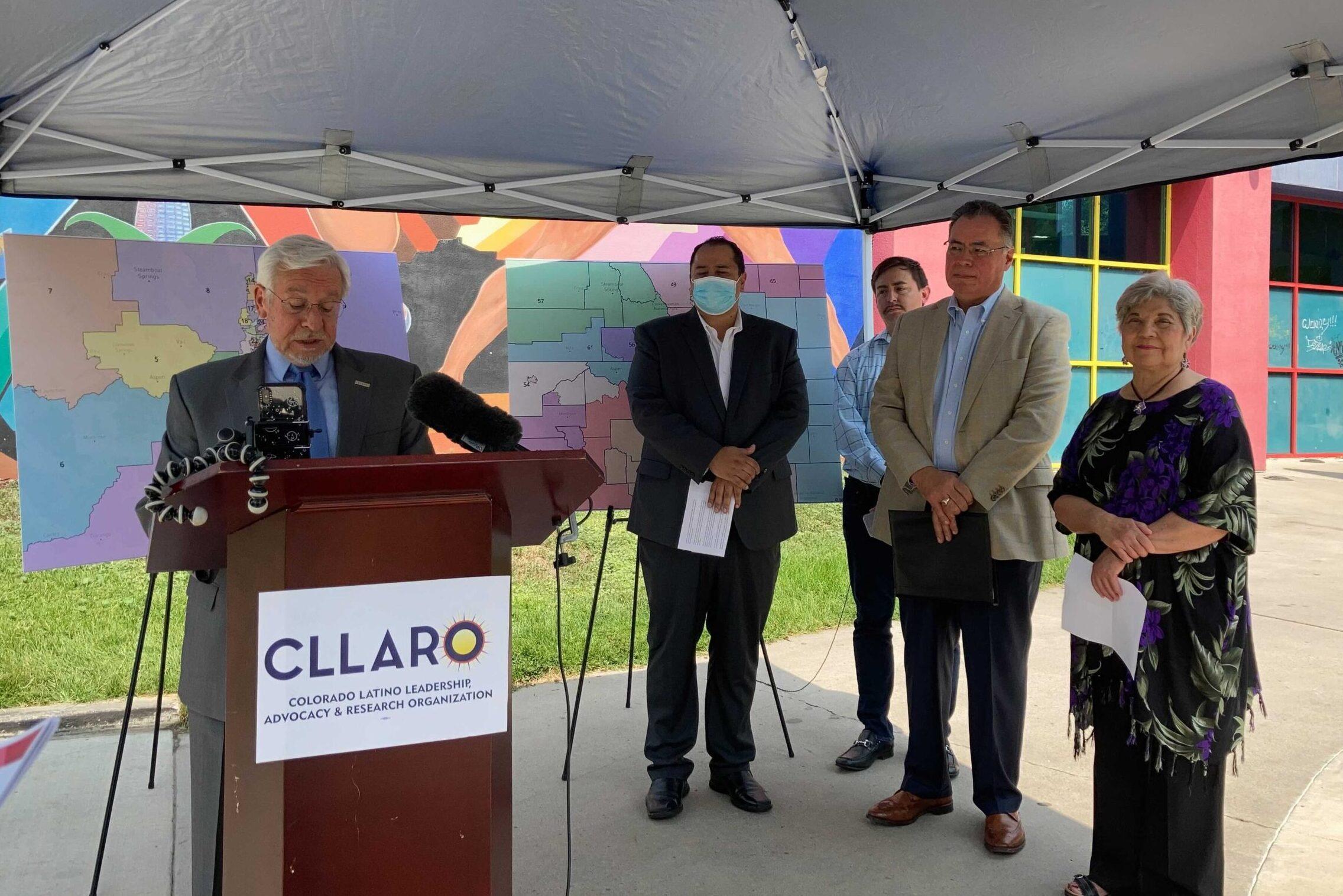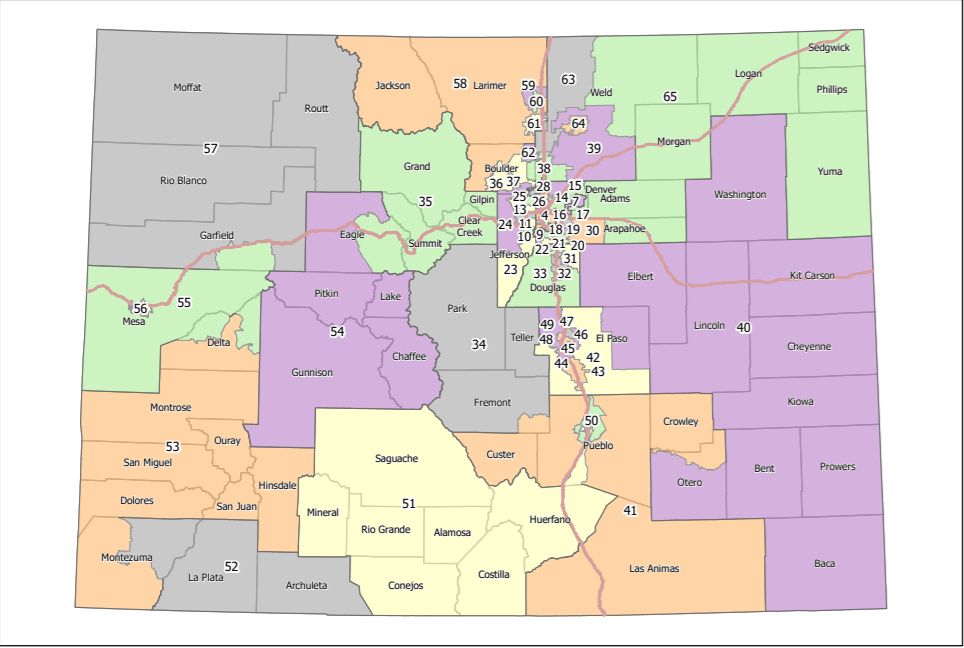
When the U.S. Census Bureau releases its final numbers on Thursday, it will start the clock on a mad dash to prepare final congressional and statehouse maps.
Nonpartisan state staffers will have just over three weeks to combine that data with feedback on the state’s draft map and release an updated version for the state’s new Redistricting Commission to consider.
For the past six weeks, Coloradans of all stripes have been weighing in on where the lines should go for the state’s congressional and statehouse districts. The final result could shape the balance of power between the parties, and the level of representation for different interest groups, for the next decade.
Several Latino organizations have raised concerns that preliminary maps dilute the political power of the state’s second-largest ethnic group.
And on Tuesday, one coalition unveiled its own proposal, which members say does a better job of giving voice to Latino residents.
The state legislative maps drawn by CLLARO, the Colorado Latino Leadership, Advocacy and Research Organization, would create 16 seats in the House with 30 percent or more Latino population and 10 in the Senate. The staff’s draft maps have 12 House and 7 Senate districts that meet that criteria.
“As the Latino population has grown in Colorado, we have continued to struggle to be appropriately represented in the redistricting process in order to have just representation in our democracy,” said Polly Baca, the first Latina to serve in Colorado’s state senate. “We ask all Coloradans and, and the commission in particular, to join us in this struggle.”

Mike Cortes, the head of CLLARO, emphasized that it is important that Latino-heavy districts not just be based in the Denver area, but throughout the state.
“The needs of Latinos in the Roaring Fork Valley are not the same as the needs of Latinos in Denver or in Pueblo or in Weld County,” Cortes said. “It is critically important that the outcomes of our redistricting process reflect the varied and distinctive nature of our Latino communities, considering each of them within their own context and ensuring that our voices are appropriately represented to our state elected officials.”
What district Pueblo and the San Luis Valley would fall into is one issue
Concerns over Latino representation have been an ongoing theme as the commissioners hold multiple public hearings in each of Colorado’s congressional districts. Even though the process is still at the draft stage and the boundaries could change, some worry commissioners may not be interested in making significant changes.
“Trying to go against what is already written down on paper and drawn out on a map is going to be difficult and a challenge for our communities,” said Democratic organizer Theresa Trujillo of Pueblo.
Her big concern is with the congressional map, which moves Pueblo and the San Luis Valley out of Lauren Boebert’s Western Slope-anchored District 3 and into District 4, which covers the Eastern Plains and the edges of metro Denver and is currently represented by Ken Buck.
“One of the issues is [the commissioners] are missing the nuance of the Latino community in Colorado, and commissioners do not understand the nuances that exist across communities,” she said.
Latino leaders aren’t the only ones hoping to see changes when the final maps are released. A coalition of civil rights groups has asked commissioners to revise how they count prison inmates. They want people in prison to be counted in their home districts, instead of where they are incarcerated.
“People in prison are paying a debt to society,” the groups stated in a recent letter to the commissions. “However, a collateral consequence of that sentence should not be to provide an unearned political benefit to more rural communities at the expense of more urban communities just because the state decided to build prisons in one particular part of the state rather than another.”
How Colorado came to this form of redistricting
Since statehood, Colorado lawmakers have had the responsibility to draw new congressional lines every 10 years. In the ‘70s, voters created a commission process to set state legislative maps, but panel members were still appointed by elected officials.
In 2018, the legislature decided it was time to get out of the redistricting business.
Lawmakers voted unanimously to put measures on the ballot that would hand over the process to independent, politically balanced commissions.
Voters agreed overwhelmingly. The commissions they set up each have four Democrats, four Republicans and four Unaffiliated voters, with lots of restrictions on who can apply to try to weed out party insiders. It’s similar to the model California adopted more than a decade ago.
“If you create a buffer between redistricting and these sorts of hyper-political interests the process will be more inclined to put the interests of the population of people, of voters first,” said Yurij Rudensky with the Brennan Center for Justice, which advocates for states to adopt redistricting commissions.
Lawmakers have mixed responses to the redistricting process
But now that the commissions’ work is underway, it’s getting a mixed reception from the policymakers who are not shut out of the process.
Republican state Rep. Colin Larson is an enthusiastic supporter. He believes the commissions will be much more fair than leaving the process in the hands of elected officials. He notes that Colorado is currently under one-party control, with Democrats in charge of the legislature and governor’s office.
“They would have basically unilateral power to just gerrymander everything. And probably, I would argue, create a map that doesn't reflect the actual people of Colorado, but would cement their majority,” Larson said.
Democrats, on the other hand, have expressed some heartburn.
State Sen. Jeff Bridges is concerned about the potential national implications of some states taking politicians out of the process, while others leave it in the hands of lawmakers. Of the 10 states using independent commissions to draw their lines this year, seven have legislatures controlled by Democrats.
“So there is a danger that you will have legislatures in red states drawing districts that minimize the voice of certain people in their state and end up sending predominantly a one-sided delegation to Congress,” Bridges said.
With fewer Democratic states taking similar steps to draw maps in their favor, it could put Democrats at a disadvantage in the U.S. House. However, Bridges said he still believes state-level independent commissions create the best outcomes for everyone.
- A Congressional District For The North Denver Metro? Here’s The First Draft Of Colorado’s New Eighth District
- Colorado’s Redistricting Commissions Can Get A Head Start On Creating Electoral Maps Despite Delayed Census Data
- Four Big Questions (And Answers) About How Redistricting Could Affect Republican Representatives In Southern Colorado
- After 10 Years Of Urban Growth, Mountain Counties Like Chaffee And Fremont Want A Rural Voice At Congress
CPR's Megan Verlee contributed to this report.
Correction: An earlier version of this story incorrectly stated when CLLARO released its maps. The organization released those maps on Tuesday, Aug. 10. This story has been updated to reflect that.








